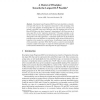Free Online Productivity Tools
i2Speak
i2Symbol
i2OCR
iTex2Img
iWeb2Print
iWeb2Shot
i2Type
iPdf2Split
iPdf2Merge
i2Bopomofo
i2Arabic
i2Style
i2Image
i2PDF
iLatex2Rtf
Sci2ools
DLOG
2009
2009
A Matter of Principles: Towards the Largest DLP Possible
Abstract. Description Logic Programs (DLP) have been described as a description logic (DL) that is in the "expressive intersection" of DL and datalog. This is a very weak guideline for defining DLP in a way that can be claimed to be optimal or maximal in any sense. Moreover, other DL fragments such as EL and Horn-SHIQ have also been "expressed" using datalog. Is DLP just one out of many equal DLs in this "expressive intersection"? This paper attempts to clarify these issues by characterising DLP with various design principles that clearly distinguish it from other approaches. A consequent application of the introduced principles leads to the definition of a significantly larger variant of DLP which we conjecture to be maximal in a concrete sense. A preliminary report on the proof of this maximality is provided. While DLP is used as a concrete (and remarkably complex) example in this paper, we argue that similar approaches can be applied to find canonical d...
Automated Reasoning | Description Logic | Description Logic Programs | DLOG 2009 | Expressive Intersection |
| Added | 17 Feb 2011 |
| Updated | 17 Feb 2011 |
| Type | Journal |
| Year | 2009 |
| Where | DLOG |
| Authors | Markus Krötzsch, Sebastian Rudolph |
Comments (0)

